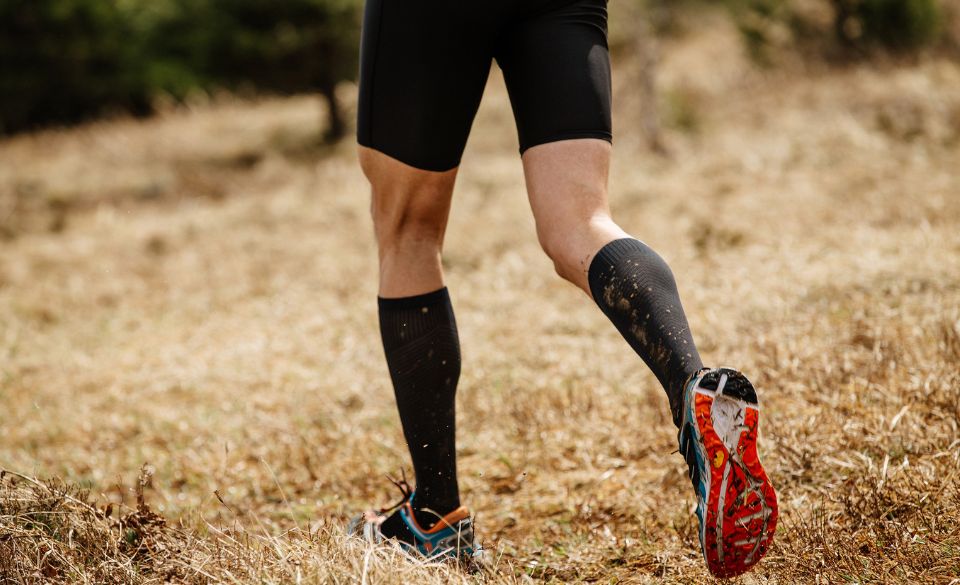
How Do Compression Socks Work? Unveiling the Science
Page Contents
You’ve probably heard the buzz about compression socks and their benefits for athletes, but have you ever wondered how they actually work their magic? These snug-fitting garments might look simple, but their design and the science behind them are anything but. In this section, we’re diving deep into the mechanics of compression socks to unravel the mystery behind their effectiveness.
Graduated Pressure: The Key Player
At the heart of compression socks’ functionality lies the concept of graduated pressure. Unlike regular socks that exert a consistent pressure on your legs, compression socks are designed to apply pressure that gradually decreases from the ankle towards the calf. This gradient pressure is what sets them apart and enables them to have a significant impact on blood circulation.
Blood Circulation and Venous Return
Compression socks primarily target your veins, arteries, and lymphatic vessels in your lower extremities. As you engage in physical activities, your muscles contract and relax, helping pump blood back to your heart. However, the return of blood from your legs to your heart can sometimes face challenges, especially when you’re standing or sitting for extended periods.
This is where compression socks come into play. The graduated pressure they exert helps to narrow your blood vessels, increasing the velocity of blood flow. This enhanced circulation not only prevents blood from pooling in your legs but also assists in the efficient removal of waste products, like lactic acid, from your muscles. As a result, your muscles receive more oxygen-rich blood, promoting better performance and reducing the risk of fatigue.
Muscle Support and Vibration Reduction
Compression socks are not only about blood flow; they also provide crucial support to your muscles. During high-impact activities like running or jumping, your muscles can experience micro-tears, leading to muscle soreness and potential injuries. The compression provided by these socks offers a gentle embrace to your muscles, reducing muscle oscillation or vibration.
This reduction in muscle vibration has two important implications. Firstly, it can help prevent muscle damage, especially during intense workouts or competitions. Secondly, it can lead to a decreased perception of muscle soreness, allowing you to train harder and recover faster. Think of compression socks as a supportive layer that cushions your muscles and tendons, reducing the risk of strain.
Recovery and Lactic Acid Clearance
Post-workout recovery is a critical phase for athletes, and compression socks can play a role here as well. After an intense session, your muscles might be flooded with lactic acid, leading to that familiar feeling of soreness. Compression socks, with their enhanced circulation support, aid in flushing out this built-up lactic acid and other metabolic waste products from your muscles.
By assisting your body in efficiently clearing out waste, compression socks can potentially speed up your recovery time. This means you can get back to training sooner and with less discomfort. The reduced muscle soreness and faster recovery make them valuable tools for athletes aiming to maintain a consistent training regimen.
In essence, compression socks are not just a fashionable accessory; they’re scientifically designed tools that harness the principles of pressure and circulation to provide a range of benefits to athletes. From enhancing blood flow and reducing muscle fatigue to supporting muscles and aiding in recovery, these socks have earned their place in the fitness world. So, the next time you slip into a pair of compression socks before a workout, remember that you’re not just getting dressed – you’re gearing up with science-backed support for your athletic endeavors.
Choosing the Right Compression Level
Now that we’ve explored the mechanics behind compression socks, let’s delve into another crucial aspect: choosing the right compression level. Compression socks come in various levels of pressure, often measured in millimeters of mercury (mmHg). Understanding these levels can help you make an informed decision based on your specific needs.
1. Mild Compression (15-20 mmHg): This level is great for everyday wear and provides basic support for your legs. It’s suitable for individuals who spend long hours standing or sitting, as it can help prevent swelling and discomfort.
2. Moderate Compression (20-30 mmHg): If you’re an active individual, this level might be more appropriate. It offers increased support for muscle recovery and can be beneficial during workouts or after intense physical activity.
3. Firm Compression (30-40 mmHg): Athletes recovering from injuries might opt for this level of compression. It provides substantial support and can assist in managing conditions like deep vein thrombosis (DVT) or edema.
4. Medical Grade Compression (40-50 mmHg and above): This level is usually recommended by healthcare professionals for specific medical conditions. It’s important to consult a healthcare provider before using socks with such high compression levels.
Tips for Wearing Compression Socks
While the benefits of compression socks are well-established, wearing them correctly is essential to maximize their effectiveness. Here are some tips to keep in mind:
1. Size Matters: Compression socks come in various sizes, so it’s crucial to choose the right size for a snug yet comfortable fit. A size that’s too small can be too tight and uncomfortable, while a size that’s too big might not provide the intended benefits.
2. Putting Them On: Putting on compression socks can be a bit of a challenge, especially with higher compression levels. To make it easier, gather the fabric like a sleeve and gradually roll it up your leg. Don’t rush; take your time to ensure even distribution of pressure.
3. Consistency Is Key: For maximum benefits, consistency is important. Consider wearing compression socks during and after workouts, as well as during long periods of standing or sitting.
4. Pay Attention to Comfort: While compression socks might feel tighter than regular socks, they shouldn’t cause discomfort or pain. If you experience numbness, tingling, or any unusual sensations, remove the socks and consult a healthcare professional.
5. Follow Recommendations: If you’re using compression socks for a specific medical condition, it’s crucial to follow the recommendations of your healthcare provider. They can guide you on the appropriate compression level and usage duration.
The Bottom Line
Compression socks are far from a passing trend – they’re backed by solid science and have proven benefits for athletes and individuals with specific needs. By understanding how they work and selecting the right compression level, you can harness their potential to enhance your athletic performance, support your muscles, and aid in recovery. Whether you’re a seasoned athlete or just starting on your fitness journey, consider adding compression socks to your arsenal of tools for a healthier, more comfortable, and more supported active lifestyle.




